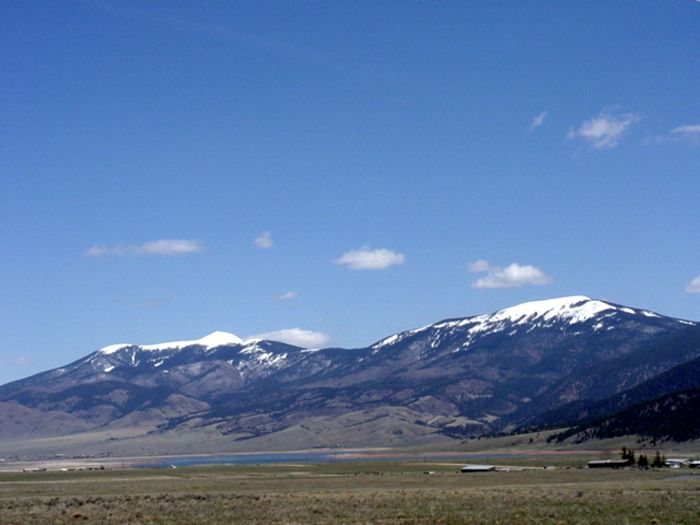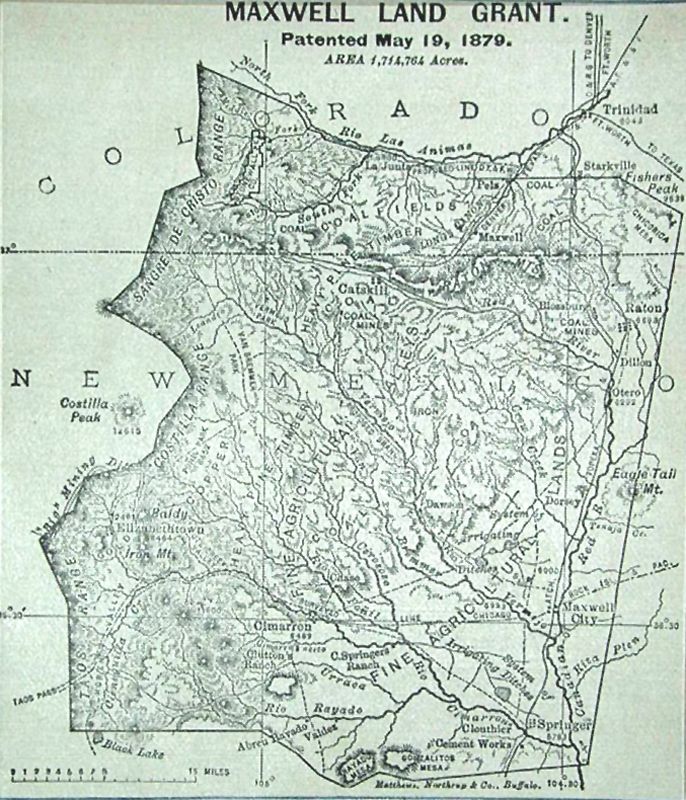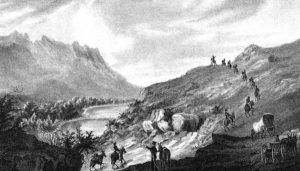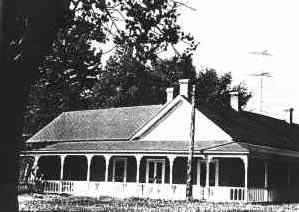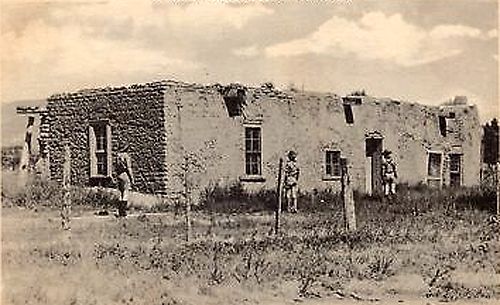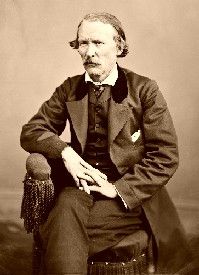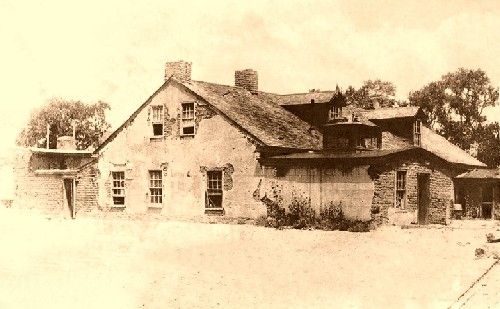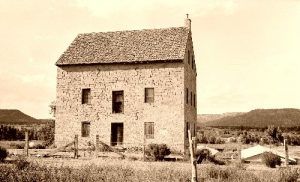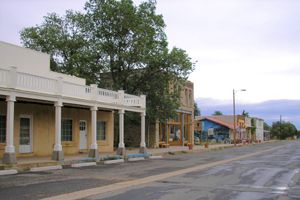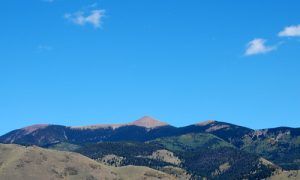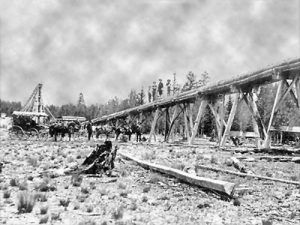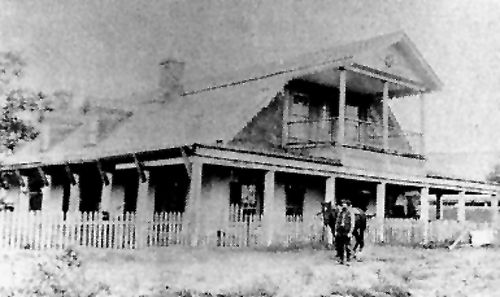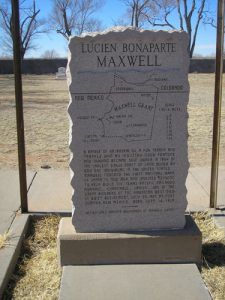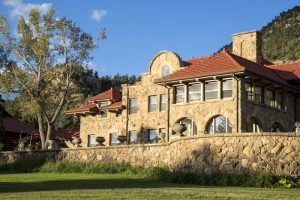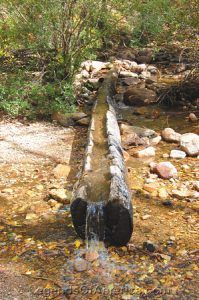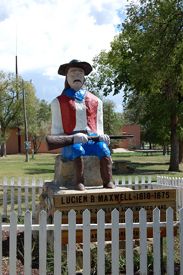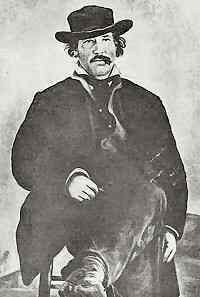
Lucien B. Maxwell
Elizabethtown – Gone But Not Forgotten
Rayado – On the Santa Fe Trail
Cimarron – Wild & Baudy Boomtown
The Maxwell Land Grant, also known as the Beaubien-Miranda Land Grant, was a 1,714,765-acre Spanish grant that was the largest ever made in what would become the United States.
The large land grant included the entire western portion of Colfax County, New Mexico, and the southern part of Las Animas County, Colorado. Two times larger than the State of Rhode Island, the area included the towns of Cimarron, Springer, Raton, and Elizabethtown in New Mexico, as well as Segundo and other towns in Colorado. The area is surrounded by breathtaking mountain views, beckoning valleys, streams teeming with fish, and hillsides alive with game.
In the beginning, the land was the undisputed territory of the Apache and Ute Indians, and later the Comanche. In 1841, just five years before the U.S. Army arrived, Charles Beaubien and Guadalupe Miranda of Taos, New Mexico, applied to Governor Manuel Armijo for the grant, promising to encourage new settlers to come to the area and utilize its resources. Beaubien was a French-Canadian trapper who came to New Mexico in 1832, became a Mexican citizen, married a 16-year-old native girl, and opened a store in Taos. Miranda was a gentleman from Chihuahua, Mexico, who had come to New Mexico on business and stayed; later, he was appointed to several government positions, including Governor Armijo’s departmental secretary.
The governor supported the grant, thinking that Mexican settlers would fend off the encroaching foreigners from the United States and hostile Indians. Two years later, another consideration was possibly revealed when Miranda and Beaubien conveyed a quarter interest in the grant to Governor Armijo. Another quarter was deeded to Taos merchant Charles Bent in return for his promise to develop the grant. Whatever the reasons, it took Armijo only three days after receiving the grant application to approve it. In 1843, after Armijo received his quarter interest, he approved an additional adjacent grant to Beaubien’s son, Narciso, and son-in-law, Stephen Louis Lee.
Then along came Charles Lucien B. Maxwell, a fur trapper from Illinois, working as a guide in the area. His work often brought him to the Beaubien-Miranda ranch, where he met and married one of Beaubien’s six daughters – Luz, who was only 15. After his marriage, Maxwell led a nomadic existence as a guide and, along with Kit Carson, led Colonel John C. Fremont across the desert to California in 1846.
John Fremont reported in his journal that Maxwell saved the expedition when he bravely confronted a band of 300 Arapaho warriors just as the shooting was about to start. “You’re a fool; God damn you!” Maxwell yelled at one of the attackers. “Don’t you know me?” The Indians were from a village where Maxwell had lived and traded a couple of years before. Instead of fighting, the two sides shook hands. Maxwell knew the land and its fierce people and the tasks of courage and self-confidence.
The same year, General Stephen Kearny led the US Army into the Mexican territory. Governor Armijo gave a brief appearance at the head of a ragtag militia defending Santa Fe but fled in fear with Guadalupe Miranda to Chihuahua. After the invasion, New Mexico was incorporated as a territory, but because of its isolation and the hostility of the Apache Indians, the area attracted few settlers. Unaffected by the US Army, Charles Beaubien stayed put, but the Taos Revolt ruined his plans for developing the grant in 1847 against the United States invaders. He turned the management of the grant over to his son, Narciso. However, both Narciso and Beaubien’s son-in-law, Stephen Lee, were killed in the Taos Revolt by a loose coalition of Indians and Mexican patriots. Also killed in the revolt was Charles Bent, who had been appointed by the U.S. Army as New Mexico’s civilian governor. Beaubien inherited his son’s interest in the other grant.
Finally, Lucien Maxwell settled down on the ranch, and he and his wife eventually had four daughters and a son. Maxwell was said to have thought his son Peter was “worthless” because the boy did not share his interests and “wasted his time with worthless friends.” He favored his daughter Virginia, who he eventually named a small settlement after, but when she grew up and married someone Maxwell disapproved of, he refused even to attend the wedding.
Meanwhile, in 1848 Beaubien purchased Stephen Lee’s interest from the administrator of his estate for $100. Having lost interest in developing the new area, he turned the project over to his son-in-law, Lucien Maxwell. Maxwell’s success would be astonishing. He lost no time in establishing a herd of cattle and increased the herds by setting up individual ranchers with their own cattle, making payments on a share basis.
He kept his best animals, continually upgrading the remaining stock, including cattle, horses, sheep, and a large goat ranch. His manager would be well known in later years as Buffalo Bill Cody.
Before Cimarron even existed, Maxwell founded the settlement of Rayado about 11 miles south of where Cimarron sits today. Rayado — which means “streaked” in Spanish, was perhaps named so for the beautiful cliffs close to the settlement. Maxwell and his wife built themselves a rambling one-story hacienda at Rayado, now a museum on the Philmont Scout Ranch.
Only Ute and Apache Indians were in the area, and they weren’t happy with Maxwell and frequently attacked the settlement. Life was risky, and settlers were reluctant to come until Maxwell brought Kit Carson from Taos, 35 miles west, as a protective presence.
Kit Carson built a place only a few miles away. Rayado was the first settlement east of the Sangre de Cristo Mountains and became a stagecoach and wagon stop along the Santa Fe Trail.
Maxwell and Kit Carson put together a couple of herds of sheep and drove them over more than a thousand miles of mountains and desert to California, netting them $20,000-$50,000 each for their efforts.
On one such drive, they reportedly made a combined $100,000 but lost it to highwaymen on the Oregon Trail. Undaunted, they assembled another herd and did it all over again.
In 1850, the United States Army established a post at Rayado, and Maxwell let the soldiers rent his first home. Partially funded by the $200 a month rent from the US Army, Maxwell started a second home in the area that eventually grew to 16 or more rooms.
In 1857, Maxwell bought Guadalupe Miranda’s interest in the grant for $2,745. In 1858 Maxwell’s father-in-law, Charles Beaubien, paid a Santa Fe law firm to petition Congress to confirm the grant under the terms of the Treaty of Guadalupe Hidalgo. The lawyers mentioned in their application that the grant had never been surveyed, and “no certain estimate of its contents” could be made. The petition also stated that only a small portion of the grant was “fit for cultivation.” The size of the grant was in question because when Beaubien and Miranda originally applied for the grant, there was a Mexican law that limited each grantor to no more than 11 square leagues. A league was a variable unit of measure, usually about three or four miles. It can, therefore, be assumed that Beaubien and Miranda intended to acquire about 22 square leagues – or about 96,000acres. The grant description was typically vague, contributing to the controversy over the years. The documentation was susceptible to later “interpretation” – so much so that what came to be known as the Maxwell Grant ended up being over two million acres.
In a hearing, Kit Carson testified that Maxwell had in just ten years turned 200 acres of wilderness into farmland, put up buildings worth $15,000, and was running 15,000 head of cattle, which he provisioned both the Indians and the US troops. Congress confirmed the grant in 1858. That same year, Maxwell moved 12 miles north, from Rayado to the banks of the Cimarron River, where he built a third home.
In 1860 prospectors and miners began to explore the area, but during the Confederate invasion in 1861-62, all mining was suspended in the territory. The area continued to become more populated, and as the number of people increased, wildlife dramatically decreased, especially the buffalo, leaving the native Indians with little to maintain their livelihood. The Apache and Comanche Indians retaliated against the newcomers by stealing livestock, including cattle, goats, and sheep, and sometimes killing the settlers. The Indian attacks and the bitter winters made life difficult for the first settlers. The U.S. Government stationed troops in the area after appeals from residents.
In 1864, after the death of his father-in-law, Maxwell and his wife bought out the five other heirs for amounts ranging from $3,000 to $6,000. Eventually, the Maxwells owned the entire grant, paying a total of $35,245 (a little over two cents per acre) for the 1,714,765 acres, and became the largest landowners in the world. He renamed the property the Maxwell Land Grant and made Cimarron his headquarters.
In the same year, he built the Maxwell House in Cimarron, as large as a city block. This was not only his home but a place of business that included a hotel, gambling rooms, a saloon, a dance hall, a billiard parlor, and an area for women of “special virtue.” Maxwell’s extravagant lifestyle was a marvel of the region where simple log and adobe houses were the norms. His mansion was said to have had high, molded ceilings, deeply piled carpets, velvet drapes, paintings in gold frames, and four pianos. A frequent visitor in Maxwell’s home, Colonel Henry Inman, stationed at Fort Union, 55 miles south, was awestruck by the opulence. Maxwell, Inman wrote, “lived in a sort of barbaric splendor, akin to that of the nobles of England at the time of the Norman conquest.” Old registers included several prominent names, including Kit Carson, Clay Allison, Davy Crockett (the desperado, a nephew of the American frontiersman), and Buffalo Bill Cody, who organized his first Wild West Show in Cimarron.
In 1864 Maxwell hired an engineering firm from Boston to design a three-story grist mill called the Aztec Mill. The mill, capable of grinding 15,000 pounds of wheat per day, supplied flour for Fort Union and distributed supplies to the Ute and Jicarilla Apache, for which The federal government compensated maxwell. By this time, Maxwell had already become a rich man from his lucrative agriculture, cattle ranching businesses, and real estate activities.
It has been estimated that Maxwell’s workforce was between 500 and 1,000. One of Maxwell’s men once said, “If a Mexican servant didn’t suit him or did anything against his orders, he took a board or plank or anything he could get hold of and whipped him with it. I knew him to tie up one man, a Mexican, and shave off the side of his head close to the skin with a butcher knife, then he struck him 15 or 20 lashes with cowhide and told him if he ever caught him on the place again, he would kill him. Some 12 or 15 years later, he returned with a bunch of stolen horses, and Maxwell killed him.”
Maxwell gained a reputation for brutality and openly flaunted his wealth. He was said to leave the solid-silver table service out in plain sight and keep as much as $30,000 in cash in an unlocked dresser drawer. Colonel Henry Inman, his frequent visitor, suggested Maxwell invest in a safe, to which he “only smiled, while a strange, resolute look flashed from his dark eyes, as he said, ‘God help the man who attempted to rob me and I knew him!'”
Once, it was said that two thieves took hundreds of dollars worth of goods from Maxwell’s Cimarron store, along with a valuable horse. Maxwell’s posse went after them and brought one of them back, at which time Maxwell clamped a 40-pound chain around his neck, imprisoned him in a cellar for two days without food and water, and then had him stripped and tied to a post and ordered one of his servants to lash him 25 times. Maxwell freed the prisoner when the servant completed the lashing, then ordered the servant stripped and tied. After Maxwell’s 15th lash, the servant passed out at the pain, and when he revived, Maxwell said: “Now, when I put you to whip a man, I want you to do it as I whipped you!”
Though he was often harsh, he was also renowned for his generosity as a host, laying out food daily for about 30 people, some guests and others traveling through the area. His grand house was a place of entertainment, where he built a track, engaged a trainer, and ran races for big purses at least every week. In his gaming rooms, cards flashed in a nightly whirl, and balls clicked on his billiard tables. Maxwell and Kit Carson would play poker for hours — Carson usually winning. Maxwell was said to have always extracted the last cent he won, though the next morning, he would often make a gift or a loan to his unsuccessful opponent of the night before. Once, it is said, after a wealthy traveler from the East insisted on knowing how much he owed for a night’s lodging, Maxwell, at last, roared, “Well, then it is twenty dollars, God damn it!” and when the flabbergasted guest handed over the huge sum, Maxwell used the bill to light his cigar.
In 1866, a year after the Civil War ended, copper was discovered on Baldy Peak, just west of Maxwell’s ranch. The value of the Maxwell Land Grant dramatically increased, and Maxwell seriously considered selling it for $75,000. However, he postponed.
Maxwell got involved with the mining activities and joined Captain William Moore, the founder of Elizabethtown, and others in 1867, to form the Copper Mining Company. The company began to extract ore from Baldy Peak and soon found the first lode of gold. The “gold fever” had taken root, and Maxwell began to collect rents and royalties from the placer miners, further adding to his vast wealth. Captain Moore’s Elizabethtown was growing by leaps and bounds, with many people storming the area searching for their fortunes.
Not to be outdone, Maxwell and some of his business associates, including Territorial Governor R.B. Mitchell, laid out another townsite just six miles from Elizabethtown. But Virginia City, named after Maxwell’s eldest daughter, was too far from the “action” and never really got off the ground.
One of the most significant problems that the miners faced was the territory’s chronic lack of water. Late in the summer, the creeks and streams would dry up, and many of the placer miners would pack up, not to return until the snows melted the following spring. In 1867, Maxwell, Moore, and other entrepreneurs tried to solve this problem by planning to build “The Big Ditch.” The project was a 41-mile aqueduct system bringing water from the Red River into Moreno Valley. The “Ditch” was constructed at the cost of over $280,000, with Maxwell putting up the bulk of the funds.
The New Mexican Miner reported at the time: “It was a colossal undertaking… a marvelous piece of engineering. The ditch forms three-fourths of a circle in its length of skirting along the edge of the mountains, bridging ravines and gullies.”
Though it was a grand idea, only about one-tenth of the water that went into the system came out the other end. The lucky entrepreneur, Maxwell, had made his first poor investment. As the water traveled over the 41 miles, it was lost due to the extensive leaks and seepage in the ditches and flumes. Though many repairs and maintenance were made, it was never a success, even though considerable gold was extracted with its aid. Later the New Mexico Miner amended its initial opinion by stating: “The Lynch Ditch, which carries water from Red River to the Moreno placer mines at Elizabethtown, is to be sold next month at a sheriff’s sale to satisfy a judgment and cost aggregating $7,000.”
From this disastrous investment, Maxwell started the First National Bank of Santa Fe but was ill-equipped to manage the complexities of banking, and he sold out at a heavy loss. He also invested $250,000 to help finance the Texas Pacific Railroad, but the project failed. It seemed as if the luck of the successful entrepreneur was coming to an end.
In 1869 Colfax County was created and named for the then vice-president of the United States. Maxwell again began to look at the possibility of selling the grant and realized that to do so; he would need to establish a clear title. He requested a survey of the grant from New Mexico’s surveyor-general, T. Rush Spencer. After Maxwell made the required deposit, Spencer sent a survey crew led by Santa Fe engineer William W. Griffin to Cimarron to begin the work.
Spencer reported his action to the Commissioner of the General Land Office in Washington, Joseph H. Wilson. When Wilson reviewed the documentation, he noticed that part of the grant extended into Colorado and questioned whether Spencer had jurisdiction over the entire grant. Questions regarding the size of the grant and the jurisdiction nagged at him, and he ordered Spencer to cancel the survey until more information could be obtained. He then referred the entire issue to his boss, Secretary of the Interior Jacob D. Cox.
Cox ruled that the New Mexico Congress had not intended to approve more than 22 square leagues to the two original grantees. Further, he stated that if Maxwell agreed to this limit, he could choose the location for that amount of land, and the survey could be completed. Otherwise, Maxwell’s money would be returned, and his claim would be ignored.
Maxwell ignored the ruling and was ready to move on, selling his interest in the grant, and in 1870, he bonded the property to Senator Chafee of Colorado and two others for $650,000. He then sold all of his other assets on the property for an additional $100,000 and moved to Fort Sumner, New Mexico, which had been de-militarized.
He purchased the buildings and other improvements and remodeled the officer’s quarters into a luxurious home with 20 rooms. Eventually, he slipped into semi-retirement and turned over most of his business affairs to his son, Peter. Five years after he sold the land grant, Maxwell had spent the money and died in poverty from what was diagnosed as uremic poisoning on July 25, 1875.
In the meantime, the property he had sold had become the site of a significant dispute called the Colfax County War. The feud began in 1873 when the Maxwell Land Grant’s new owners tried removing local settlers from land they said they owned. The vicious range war would last until 1887, before it was finally resolved.
During the 1900s, the land was gradually subdivided, and ranchers, loggers, and private organizations bought the property. Five Hundred thousand acres became the hideaway home of Chicago grain baron William Bartlett, who built three mansions and a railroad for his guests’ convenience. Later 200,000 acres of the private retreat were purchased and became the Vermejo Park Club, whose members included celebrities and the wealthy, such as Mary Pickford, Douglas Fairbanks, Cecil B. DeMille, Herbert Hoover, and Harvey Firestone. However, the club closed when the Great Depression was evident, and the property reverted to ranching.
The Vermejo Park property and other lands, totaling almost one million acres, were eventually sold to W.J. Gourley, a Texas oilman from Fort Worth. Mr. Gourley wanted to expand the existing elk herd and purchased several hundred elk from Yellowstone National Park for $5 per head. He also bred and raised wild turkeys to increase the wild bird population. When Mr. Gourley died in 1970, the land was sold to the Pennzoil Company for a bargain of $26 million. Penzoil donated 100,000 acres to the Forest Service in 1982. Now, media magnate Ted Turner owns part of the original land.
In 1922, much of the land, now known as the Philmont Scout Ranch, was purchased by Oklahoma oil millionaire Waite Phillips. Mr. Phillips spent six months of each year on the ranch, eventually amassed over 300,000 acres, and renamed it Philmont, which is based on the Spanish word for mountain “Monte.”
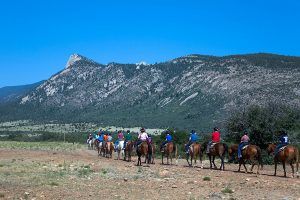
Philmont Scout Ranch, New Mexico courtesy Philmont Facebook Page.
The Philmont Ranch became a showplace where cattle and sheep grazed in the pasture. Phillips built a large Spanish Mediterranean home for his family and named it Villa Monte. He also developed horse trails, hiking trails, and hunting cabins for his friends and family.
In 1938, Waite Phillips gave 35,857 acres of the ranch to the Boy Scouts of America, along with $61,000 to be used to develop it. In 1941, another gift of 91,000 acres was added. Phillips realized that the property’s maintenance and development cost could not be derived entirely from camper fees and included in the endowment the gift of his 23-story Philtower Building in Tulsa, Oklahoma.
Later, in 1963, through the generosity of Norton Clapp, vice-president of the National Council of the Boy Scouts of America, another piece of the Maxwell Land Grand was purchased and added to Philmont. This was the Baldy Mountain mining area consisting of 10,098 acres. Other large ranches and small tracts were carved from the grant, and today there are many owners of the land that Lucien B. Maxwell once held.
The Old Mill Museum, which Maxwell operated as the Aztec Mill until 1870, is in the Cimarron Historic District. But Maxwell’s Cimarron home didn’t fare so well, as it quickly fell to ruins when Maxwell left.
The Philmont Scout Ranch now maintains the reddish adobe buildings of Rayado. Scout leaders dressed in period costumes lead visitors through Maxwell’s adobe hacienda. It has been restored from the two original rooms that had survived. In neighboring buildings are the 1860 stagecoach stop, store, and accommodations for stage passengers.
Clear Creek, the site where they found the Reverend Tolby’s body after he was killed in the Colfax County War, was once a popular stop along the scenic highway when Weather’s Store resided in Cimarron Canyon, selling refreshments and novelty items to the travelers stopping by for a drink of Clear Creek’s cool waters flowing through a huge log. The store was moved to Eagle Nest and, for years, was still in operation as an Antique Shop run by the original owner’s daughter. Today, the site is an RV Park.
Maxwell’s last home in Fort Sumner is long gone but has been recreated repeatedly in movie sets. After Maxwell’s death, it became the property of his son Pete, and it was in this building that a houseguest of Pete Maxwell (and more particularly of his daughter Paulita) by the name of William “Billy the Kid” Bonney was shot by Pat Garrett in 1881.
In eastern New Mexico, 200 miles from the snow-capped peaks and cool valleys of Moreno Valley, the land baron lies buried in an almost forgotten corner of the dusty plains of Fort Sumner, New Mexico. In the same small cemetery are the graves of the outlaw Billy the Kid and two of his companions, which are buried under a headstone inscribed “Pals.”
Lucien B. Maxwell still has descendants in the area. One of these was Moe Finley, his great-great-grandson who ran the Mountain View Cabins and the Eagle Nest Marina at Eagle Nest Lake, where Maxwell once had a store. Moe kept a framed copy of a Maxwell Land Grant Company map on his dining room wall. Unfortunately, he didn’t inherit it but rather had to buy it. Moe laughingly said of Lucien: “I wish he’d left us the Vermejo, or 100,000 acres–or something!” Unfortunately, Moe Finley died in 2017. The site is now called Eagle Nest Cabins & Marina.
The only monument to Maxwell on the original grant is a concrete folk-art sculpture in Cimarron, New Mexico, where Maxwell sits looking restless, facing the west with a rifle in hand. Interestingly, the curator of the Aztec Museum said that the statue wasn’t really built for Maxwell but rather for a man named Henry Springer. But Mr. Springer didn’t like it and said: “Statues are for dead people.” So, the artist dedicated it to Maxwell instead.
© Kathy Alexander/Legends of America, updated October 2022.
Also See:
Kit Carson – Legend of the Southwest
Santa Fe Trail – Highway to the Southwest
Tales & Trails of the American Frontier
Special Note: This story about the Maxwell Land Grant, one of the first articles published on Legends of America in 2003, explores an area close to our heart and the inspiration of our website — the Moreno Valley of New Mexico.

